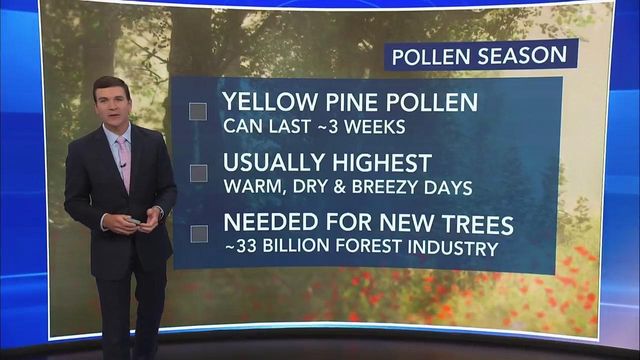The Pollening: Triangle turns yellow seemingly overnight
If there is one thing certain in spring, it is pollen.
Posted — UpdatedSpring has sprung, and many of you have been soaking up the sun and taking in all that spring in North Carolina has to offer.
Laura Ingalls Wilder once said, “Some old-fashioned things like fresh air and sunshine are hard to beat.”
Those “old-fashioned” characteristics of spring may need to be adapted slightly for us North Carolinians, because if there is one thing certain in spring, it is pollen.
According to Dr. Robert Bardon, a professor of forestry and environmental resources at N.C. State University, pollen is necessary for the production of pine seeds that grow to become pine trees.
Pine pollen season is a reminder of the importance of the pine tree to our state, that it supports the forest industry, which has a $32.8 billion dollar impact on North Carolina’s economy.
Bardon also mentioned that the overall pine pollen season can last weeks. The amount of pine pollen in the atmosphere tends to be highest early in the morning on warm, dry, breezy days and lowest during chilly, wet periods.
Contributing factors to pollen season
Climate Central, an independent organization of leading scientists and journalists that research and report the facts about our changing climate, shows that our average daily spring temperature has increased by over 3 degrees since 1970.
While that may not seem too impactful, the increase in our daily average temperature can increase the growing season which, in turn, increases the length of our pollen season. You may notice that a minor change in one aspect of our climate, like the temperature, can have a ripple effect through an entire season, if not for an extended duration.
Climate Central also pointed out that the impacts of climate change on seasonal allergies do not just change the start time or length of pollen season, they also intensify it.
The amount of carbon dioxide in the atmosphere directly impacts pollen concentrations because it can stimulate plant growth. Many people may experience allergies as a minor inconvenience, but seasonal allergies can have serious consequences and decreased quality of life for those with respiratory problems like asthma. With a longer pollen season and high pollen concentrations, asthma and allergy reactions can become even more severe.
So, what can we expect?
When looking at the forecast for the next five days, we see our temperatures will remain above normal with dry conditions continuing through at least Friday afternoon. This means our pollen levels will continue to run high, so keep that in mind if your health is impacted by tree pollen.
Luckily, scattered rain will return this weekend, and that will not only knock some of this pollen out of the air but out of the trees as well.
WRAL’s team of meteorologists is devoted to learning more about our changing climate and its impact on our weather in North Carolina.
As always, WRAL is the station to turn to for the latest pollen levels this spring and when inclement weather could impact your plans.
Related Topics
• Credits
Copyright 2024 by Capitol Broadcasting Company. All rights reserved. This material may not be published, broadcast, rewritten or redistributed.






